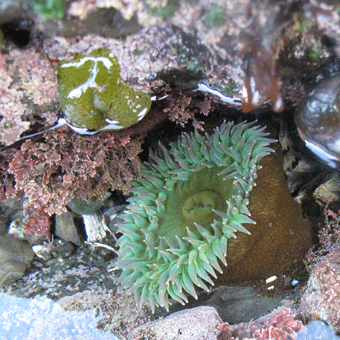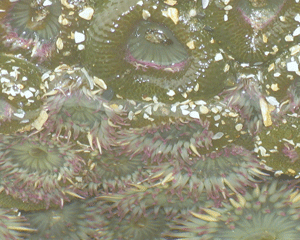Sea anemones thrive on a special partnership
 Green sea anemones have single-celled algae living in their tissues. The algae probably have a relatively safe place to live, but the sea anemone may get a good portion of its food from the algae, as well as some camouflage. Anemones living in dark crevasses are paler green.
Green sea anemones have single-celled algae living in their tissues. The algae probably have a relatively safe place to live, but the sea anemone may get a good portion of its food from the algae, as well as some camouflage. Anemones living in dark crevasses are paler green.
Similar to their jellyfish relatives, sea anemones use their tentacles to sting and retrieve prey. Small fish, open snails, and other intertidal animals are caught by the tentacles, pulled into the mouth, and eaten. An anemone with tentacles tucked insstyle=ide while underwater is probably eating; an anemone with tentacles tucked inside when out of the water is probably protecting its tentacles and mouth from drying and other damage.
Poking anemones may cause them to squirt out valuable water they need to stay hydrated during low tide, please observe gently.
 Aggregating Anemone
Aggregating Anemone
The most commonly encountered sea anemone in Oregon’s tidepools, aggregating anemones may be overlooked because they’re small. Aggregating anemones also thrive high up in the intertidal and people often overlook them because the anemones are closed up when exposed during the low tide that draws people to the shore. Aggregating anemones are often packed closely together, making it more difficult to make out individual animals; the shell bits on the outside complete the camouflage.
Why are aggregating anemones sometimes packed tightly together? Anemones reproduce by shedding eggs and sperm into the water, or by budding, or by splitting in two—cloning: aggregating anemones are especially good at cloning. A cloning aggregating anemone starts by stretching into a long oval then a long figure 8, eventually dividing into two genetically identical individuals.
Look for the pink-tipped tentacles in an open aggregating anemone while you’re looking for cloning individuals and boundaries between clone colonies. If you're lucky, you may even see the acrorhagi, or specialized tentacles used by this anemone to warn off members of other clones.
